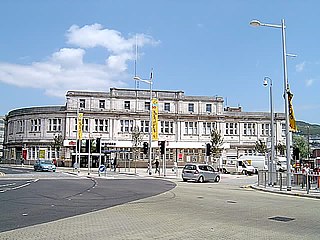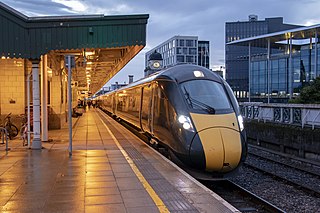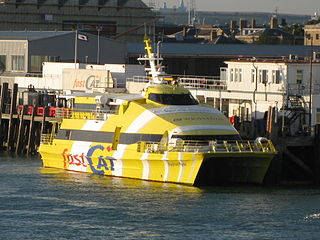
The Bristol Channel is a major inlet in the island of Great Britain, separating South Wales from Devon and Somerset in South West England. It extends from the lower estuary of the River Severn to the North Atlantic Ocean. It takes its name from the English city of Bristol, and is over 30 miles (50 km) wide at its western limit.

Cardiff Bay Barrage lies across the mouth of Cardiff Bay, Wales between Queen Alexandra Dock and Penarth Head. It was one of the largest civil engineering projects in Europe during construction in the 1990s.

Ilfracombe is a seaside resort and civil parish on the North Devon coast, England, with a small harbour surrounded by cliffs.

Cardiff Central railway station is a major station on the South Wales Main Line, located in the capital of Wales, Cardiff. It is one of the city's two urban rail network hubs, along with Cardiff Queen Street. Opened in 1850 as Cardiff station, it was renamed Cardiff General in 1924, and then Cardiff Central in 1973.

Penarth is a town and community in the Vale of Glamorgan, Wales, approximately 4 miles (6.4 km) south of Cardiff city centre on the north shore of the Severn Estuary at the southern end of Cardiff Bay.

Newport railway station is the second-busiest railway station in Wales, situated in Newport city centre. It is 133.5 miles (215 km) from London Paddington on the British railway network.

The City Line is a commuter railway line in Cardiff that runs between Radyr and Cardiff Central via Fairwater.

The Vale of Glamorgan Line is a commuter railway line in Wales, running through the Vale of Glamorgan from Barry to Bridgend, via Rhoose and Llantwit Major.

Swansea railway station serves the city of Swansea, Wales. It is 186 miles 7 chains (299 km) measured from London Paddington on the National Rail network.

The South Wales Main Line, originally known as the London, Bristol and South Wales Direct Railway or simply as the Bristol and South Wales Direct Railway, is a branch of the Great Western Main Line in Great Britain. It diverges from the core London-Bristol line at Royal Wootton Bassett beyond Swindon, first calling at Bristol Parkway, after which the line continues through the Severn Tunnel into South Wales.

The West Wales lines are a group of railway lines from Swansea through Carmarthenshire to Pembrokeshire, West Wales. The main part runs from Swansea to Carmarthen and Whitland, where it becomes three branches to Fishguard, Milford Haven and Pembroke Dock.

Transport in Wales is heavily influenced by the country's geography. Wales is predominantly hilly or mountainous, and the main settlements lie on the coasts of north and south Wales, while mid Wales and west Wales are lightly populated. The main transport corridors are east–west routes, many continuing eastwards into England.

The Barry Railway Company was a railway and docks company in South Wales, first incorporated as the Barry Dock and Railway Company in 1884. It arose out of frustration among Rhondda coal owners at congestion and high charges at Cardiff Docks as well the monopoly held by the Taff Vale Railway in transporting coal from the Rhondda. In addition, the Taff Vale did not have the required capacity for the mineral traffic using the route, leading to lengthy delays in getting to Cardiff.
Transport in Cardiff, capital and most populous city in Wales involves road, rail, bus, water and air. It is a major city of the United Kingdom and a centre of employment, government, retail, business, culture, media, sport and higher education.

HSC FastCat Shanklin is a high speed catamaran ferry which operated between the Isle of Wight and mainland England. She operated on the Wightlink Ryde Pier to Portsmouth route from 2000 to 2009 along with her sister ship HSC FastCat Ryde. Prior to working for Wightlink, the ship worked in Singapore and was named Water Jet 2. In 1999, the year before it was sold to Wightlink, its name was changed to Supercat 18.

HSC FastCat Ryde is a high speed catamaran ferry. The vessel was originally built in Singapore for service in the Philippines as Water Jet 1. She was bought by Wightlink in 2000 and following an extensive refit entered service on the Ryde Pier to Portsmouth route in August of that year along with her sister ship HSC FastCat Shanklin.
The Swansea Cork ferry was a 10-hour ferry crossing that linked Swansea in South Wales with the Port of Cork in Ireland. The ferry route was last operated by Fastnet Line from 2010 to 2012, although no commercial passenger sailings took place after 2011. Between 1987 and 2006 the service was operated by Swansea Cork Car Ferries Ltd. Prior to the revival of the Cork–Swansea route by Swansea Cork Car Ferries Ltd. the former Irish semi-state owned ferry company, British & Irish Steam Packet Company which became known simply as the B+I Line which had operated the route from 1969 until 1979. In 1979 the B+I Line decided to switch the Cork–Swansea service over to a Cork–Pembroke Dock service instead. Prior to B+I Line's Cork Swansea ferry, they had a previous ferry service that sailed from Cork to Fishguard in South Wales. Over the years numerous ships had different departure points from Cork. Originally, the ferry came right up into Cork city centre and would have docked across from Penrose House at Penrose Quay and in the 1970s ferries departed Cork from a new Ferry Terminal based down stream at Tivoli Docks alongside a large container terminal. From around the early 1980s onwards ferries would later depart from yet another new passenger car Ferry Terminal based at Ringaskiddy Deepwater Berth in the lower part of Cork Harbour.

Network Rail planned to spend £5 billion on modernising the Great Western Main Line, its South Wales branch and other associated lines. The modernisation plans were announced at separate times but their development time-scales overlap in the 2010s. The work included electrification, resignalling, new rolling stock and station upgrades. According to Network Rail, the modernisation started in June 2010 and was due to end in 2017. As of December 2019, electrification was complete as far west as Cardiff Central, and also from Reading to Newbury.
Rail transport in Cardiff has developed to provide connections to many other major cities in the United Kingdom, and to provide an urban rail network for the city and its commuter towns in southeast Wales. Today, there are three train operating companies in Cardiff: Great Western Railway, CrossCountry and Transport for Wales.

The Great Western Railway's ships operated in connection with the company's trains to provide services to Ireland, the Channel Islands and France. Powers were granted by Act of Parliament for the Great Western Railway (GWR) to operate ships in 1871. The following year the company took over the ships operated by Ford and Jackson on the route between Wales and Ireland. Services were operated between Weymouth, the Channel Islands and France on the former Weymouth and Channel Islands Steam Packet Company routes. Smaller GWR vessels were also used as tenders at Plymouth and on ferry routes on the River Severn and River Dart. The railway also operated tugs and other craft at their docks in Wales and South West England.


















